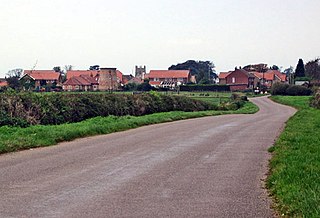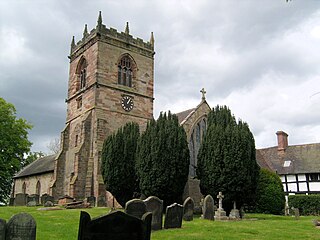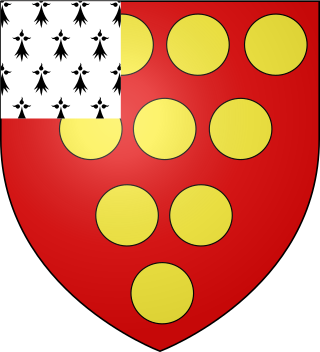
The Lord Warden of the Cinque Ports is a ceremonial official in the United Kingdom. The post dates from at least the 12th century, when the title was Keeper of the Coast, but may be older. The Lord Warden was originally in charge of the Cinque Ports, a group of five port towns on the southeast coast of England that was formed to collectively supply ships for The Crown in the absence at the time of a formal navy. Today the role is a sinecure and an honorary title, and fourteen towns belong to the Cinque Ports confederation. The title is one of the higher honours bestowed by the Sovereign; it has often been held by members of the Royal Family or prime ministers, especially those who have been influential in defending Britain at times of war.
Sir Bertram de Criol was a senior and trusted Steward and diplomat to King Henry III. He served as Constable and Keeper of Dover Castle, Keeper of the Coast and of the Cinque Ports, Keeper of the receipts, expenses and wardships of the archbishopric of Canterbury, Constable of the Tower of London and Sheriff of Kent.
Robert de Auberville, of Iham and Iden, Sussex, representative of a wealthy Norman family in Kent and Sussex, was a Justiciar in Kent, Constable of Hastings Castle, and Keeper of the Coast to King Henry III of England.

Fulk FitzWarin, variant spellings, the third, was a prominent representative of a marcher family associated especially with estates in Shropshire and at Alveston in Gloucestershire. In young life, early in the reign of King John (1199–1216), he won notoriety as the outlawed leader of a roving force striving to recover his familial right to Whittington Castle in Shropshire, which John had granted away to a Welsh claimant. Progressively rehabilitated, and enjoying his lordship, he endured further setbacks in 1215–1217.

Croxton Kerrial is a village and civil parish in the Melton borough of Leicestershire, England, 6.6 miles (10.6 km) south-west of Grantham, 7.9 miles (12.7 km) north-east of Melton Mowbray, and 0.5 miles (0.8 km) west of Leicestershire's border with Lincolnshire. The civil parish includes the village of Branston and had a population of 530 at the 2011 census.

Leiston Abbey outside the town of Leiston, Suffolk, England, was a religious house of Canons Regular following the Premonstratensian rule, dedicated to St Mary. Founded in c. 1183 by Ranulf de Glanville, Chief Justiciar to King Henry II (1180-1189), it was originally built on a marshland isle near the sea, and was called "St Mary de Insula". Around 1363 the abbey suffered so much from flooding that a new site was chosen and it was rebuilt further inland for its patron, Robert de Ufford, 1st Earl of Suffolk (1298-1369). However, there was a great fire in c. 1379 and further rebuilding was necessary.
Sir William Hawte was a prominent member of a Kentish gentry family of long standing in royal service, which, through its near connections to the Woodville family, became closely and dangerously embroiled in the last phases of the Wars of the Roses.

Lapley Priory was a priory in Staffordshire, England. Founded at the very end of the Anglo-Saxon period, it was an alien priory, a satellite house of the Benedictine Abbey of Saint-Remi or Saint-Rémy at Reims in Northern France. After great fluctuations in fortune, resulting from changing relations between the rulers of England and France, it was finally dissolved in 1415 and its assets transferred to the collegiate church at Tong, Shropshire.

Butley Priory, sometimes called Butley Abbey, was a religious house of Canons regular in Butley, Suffolk, dedicated to The Blessed Virgin Mary. It was founded in 1171 by Ranulf de Glanville, Chief Justiciar to King Henry II (1180-1189), and was the sister foundation to Ranulf's house of White canons (Premonstratensians) at Leiston Abbey, a few miles to the north, founded c. 1183. Butley Priory was suppressed in 1538.
Campsey Priory,, was a religious house of Augustinian canonesses at Campsea Ashe, Suffolk, about 1.5 miles (2.5 km) south east of Wickham Market. It was founded shortly before 1195 on behalf of two of his sisters by Theobald de Valoines, who, with his wife Avice, had previously founded Hickling Priory in Norfolk for male canons in 1185. Both houses were suppressed in 1536.

Flixton Priory was a nunnery under a prioress following the Augustinian rule, which formerly stood in the parish of Flixton in the north of the English county of Suffolk, about 3 miles (4.8 km) south-west of Bungay. It was founded by Margery de Creke in 1258, and was dissolved in 1536–37. It was the poorest of the nunneries within the Diocese of Norwich. The site of the priory, which was enclosed by a moat, was at the present Abbey Farm, where little apart from the position in the landscape and a small section of standing wall remain to be seen. It was scheduled as an ancient monument in 1953. It is privately owned and is not open to the public. It is suggested that some parts of the masonry may have been re-used in St Peter's Hall at St Peter, South Elmham.

Ralph Fitzwilliam, or Ralph, son of William de Grimthorpe, Lord of Greystoke, was a feudal baron with extensive landholdings in the North of England, representative of a manorial lordship seated where Grimthorpe Hill rises to commanding views a mile to the north of Pocklington in the Yorkshire Wolds. He gave sustained military service and leadership through the Scottish and Welsh campaigns of Edward I and was summoned to parliament from 1295 to 1315. His marriage in c. 1282 brought him other manors including Morpeth in Northumberland and its appurtenances. In 1297 he was enfeoffed as tenant-in-chief of the entire barony of Greystoke, seated at Greystoke in Cumberland but with Yorkshire estates, through his matrilineal Greystok descent. He entered upon these in his own right in 1306. Having served in the retinue of Aymer de Valence, during the first decade of Edward II's reign he remained dependable as a military leader and royal lieutenant in the defence administration of the northern counties and Scottish marches. His descendants adopted the Greystoke name, and their inheritance continued in the male line until the end of the 15th century.
Sir Nicholas Haute, of Wadden Hall (Wadenhall) in Petham and Waltham, with manors extending into Lower Hardres, Elmsted and Bishopsbourne, in the county of Kent, was an English knight, landowner and politician.
John de Echingham S.T.D. was an English medieval Chancellor of the University of Oxford, who held that dignity for three consecutive years.
William Devereux, was an important Marcher Lord, and held Lyonshall Castle controlling a strategically vital approach to the border of Wales. The castle's significance was heightened by the rebellion of Llywelyn ap Gruffudd, Prince of Wales. With strong family ties to the politically powerful families of Cantilupe and Giffard, his support was strongly sought after by Henry III and Simon de Montfort throughout the Second Barons' War.

Ralph de Greystoke, 1st Baron Greystoke, was an English peer and landowner.
John Darras (c.1355–1408) was an English soldier, politician and landowner, who fought in the Hundred Years' War and against the Glyndŵr Rising. A client of the FitzAlan Earls of Arundel, he served them in war and peace, helping consolidate their domination of his native county of Shropshire. He represented Shropshire twice in the House of Commons of England. He died by his own hand.

William la Zouche, 1st Baron Zouche (1276/86–1352), lord of the manor of Harringworth in Northamptonshire, was an English baron and soldier who fought in the Wars of Scottish Independence. He is referred to in history as "of Harringworth" to distinguish him from his first cousin Alan la Zouche, 1st Baron la Zouche (1267–1314) of Ashby de la Zouch in Leicestershire.
Nicholas Devereux II of Chanston (Vowchurch) was an Anglo-Norman nobleman living during the reigns of Henry III of England. The Devereux were a prominent knightly family along the Welsh Marches during the thirteenth century, and Nicholas would play an integral role in attempts to control the Welsh Marches during the thirteenth century.

Sir Thomas de Felton was an English landowner, military knight, envoy and administrator. He fought at the Battle of Crécy in 1346, and the Capture of Calais in 1347. He was also at the Battle of Poitiers in 1356. A recurrent figure in the Chronicles of Jean Froissart, he was a signatory to the Treaty of Brétigny in 1360. In 1362 he was appointed Seneschal of Aquitaine. He accompanied Edward the Black Prince on his Spanish campaign. He was taken prisoner by Henry of Trastámara's forces in 1367. In 1372 he was appointed joint-governor of Aquitaine and seneschal of Bordeaux. He caused Guillaume de Pommiers and his secretary to be beheaded for treason in 1377. He was invested a Knight of the Garter in 1381.










